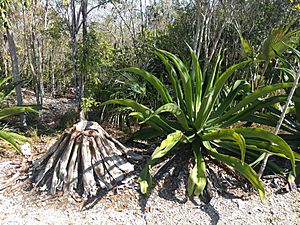Agave caymanensis facts for kids
Quick facts for kids Agave caymanensis |
|
|---|---|
 |
|
| Conservation status | |
| Scientific classification | |
| Genus: |
Agave
|
| Species: |
caymanensis
|
The Agave caymanensis is a special type of agave plant. It grows only in the Cayman Islands, specifically on Grand Cayman, Little Cayman, and Cayman Brac. This plant likes dry, bushy areas and can be found all over the islands.
Contents
What Does the Cayman Agave Look Like?
The Cayman agave can grow quite tall, up to 4 meters (about 13 feet) high and 3 meters (about 10 feet) wide. It has a short trunk that gets covered by old, dead leaves. Its leaves are very big and succulent, meaning they are thick and store water, like a cactus. The edges of its leaves have sharp thorns.
How Does the Cayman Agave Grow?
This agave is monocarpic. This means it flowers only once in its long life, and then it dies. When these plants flower, they often do it at the same time. Young rock iguanas sometimes use the hollow, dead flower stalks as a safe place to hide.
When Was This Plant Discovered?
For a long time, people thought this plant was the same as another agave called A. sobolifera. But in 2012, a scientist named Proctor officially described it as its own unique species.
How Long Does the Cayman Agave Live?
The Cayman agave has a long generation length, which means it takes a long time for a new plant to grow up and have its own seeds. This can take anywhere from 20 to 70 years! It's a very important plant in the dry, bushy areas of the Cayman Islands. These areas are called xerophytic shrublands because the plants there are good at living with very little water.
Why Is the Cayman Agave Endangered?
The A. caymanensis is an endangered plant. This means its population is shrinking, and it's at risk of disappearing forever. The IUCN (a big group that protects nature) has given it this status.
What Are the Main Threats?
The biggest problem for the Cayman agave is losing its home. People are building more homes, hotels, and roads on the islands. They are also cutting down forests and turning land into farms. All of this building and development means less space for the agave to grow naturally.
How Many Are Left?
It's estimated that there are now just over 1 million Cayman agave plants. This is a big drop from about 1.3 to 1.5 million plants just a few generations ago. Scientists think the population could drop by another 61% in the next 60 to 100 years.
Are There New Dangers?
Another worry is an invasive bug called the Scyphophorus acupunctatus weevil. This weevil eats agaves and could cause problems for the Cayman agave, especially since it affects similar plants on nearby islands.


